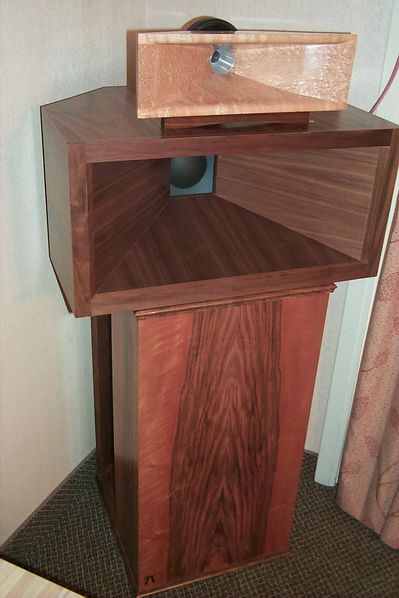I was really pleased with how everything turned out at the recent Great Plains Audiofest last weekend. I wrote some impressions in the General forum on AudioRoundTable.com, but I wanted to mention a few things here that I didn't think were appropriate on the General forum. seven π at Great Plains Audiofest
seven π at Great Plains Audiofest
The Audiophile Series seven π speakers sounded really nice in the room at Embassy Suites. I've always loved those speakers, and I think going back to a three-way was a very good thing. These are my best speakers ever. I've always been proud of my loudspeaker designs, but these are extra special. They make it hard to shut off the music to go do the stuff you need to do. It's always just one more song, just one more song...
The seven π's of the 1980's with JBL 2205 woofers and JBL 2105 mids were like that too. But I really think this new model with the large format midhorn tops them. They're just right, man they're right. I don't mean to be imprudent, but I am excited about these speakers.
The midhorn has been out for about a year now, and several people have implemented them. I've been able to test them with various drivers, find some that worked well and others that weren't as good. And I've been able to listen to the speakers for a long time, to live with them and to evaluate them.
The thing that makes the midhorn so special to me is that it goes so low. When used on a π cornerhorn, the mouth is one foot away from each wall. That makes boundary reinforcement work very well from 300Hz down, so the walls act as very long flare extensions. This makes what is essentially an undersized horn act like it were huge. The response is excellent, smooth and extended. The places you really notice it are musical passages with piano, cello and vocals. With its range this deep, wavelengths are long and crossover to the woofer is seamless. And with the angle set the same as the walls, everything all the way up comes from the same direction and fills the room evenly. These speakers are magical to me.
 seven π, up close and personal
seven π, up close and personal
I've been spoiled with Bill Martinelli's great cabinetry, and so searching for another cabinet maker was a pretty difficult job. Martinelli is a hard act to follow. I wouldn't have done it, but Bill says it's hard for him to justify building the inexpensive stuff. So he opted out.
I've used four separate cabinet shops in Tulsa prior to 2000, and this year, I went to three others in one year alone. But I think I've found Bill's match. Not that it's a competition or anything, and everyone has their own style. Bill Martinelli will still build custom cabinets, so if you're up north and you want an excellent cabinet, ask Martinelli to provide a quote for you.
Ironically, I've known Brad Smith, my current cabinetmaker, for 15 years. I can't believe I didn't ask him to build cabinets sooner. He has done an excellent job for me in the past few months, and we've built several loudspeakers together. He can build with standard woods and finishes, or with exotics and modelled woods to provide the finest Grande cabinets. What you saw at GPAF was my bass bins built by Martinelli and my midhorns built by Smith. Both were exquisite.
I've always liked π cornerhorns best, but to use them requires having two good corners. A long time ago, it was really a sort of intuitive thing. It just seemed that launching from the corners focused the sound naturally, and listening proved them to sound most natural to me. But it wasn't until much later that I realized what was happening in the reverberent field.
Speakers that are DI matched, like my three π and four three π models, are very good where corners aren't available. They're easier to place because they aren't bound to corners. And you still get the lows all the way up through the vocals and into the overtones coming from a single driver, so the sound is very natural that way too.
Then there are the very simple two-way models, like my one π and two π speakers. These are more traditional speakers with simple crossovers optimized for on-axis response. I had a pair of the tower two π speakers out at GPAF, because I always like to show a budget system that can be assembled for under $1000.00.
The two π tower kit is $80.00 each, and the Stoetkit is $750.00 from FSAudio, so this gets you just under $1000.00 for a complete system, by the time you buy wood and materials to assemble your speakers. At MAF, I demo'ed with a Harman Kardon HK3470 that only cost $400.00 new. It sounded very nice too. Not as groovy cool looking, but certainly not ugly and a very capable amp.
The Nelson Audio amp I showed at GPAF is about $1000.00 by itself. So that puts you at about $1500.00 to $2000.00, realistically, by the time you get a decent CD player and a nice finish on your speakers. But the sound is really great and plenty loud. Not 2 watt SET and mini-monitor loud, I'm talking turn it down loud, you're going to get the cops called out loud. And I'm not talking thrashing loud either, I'm talking quality, enough to play complex passages without breaking up in the crescendoes.
 two π tower
two π tower







